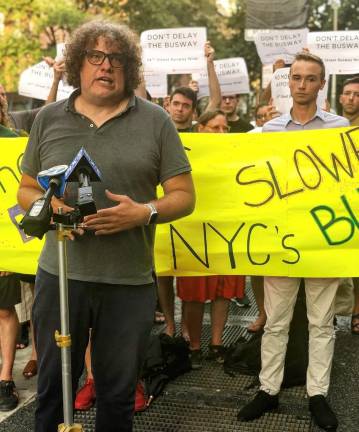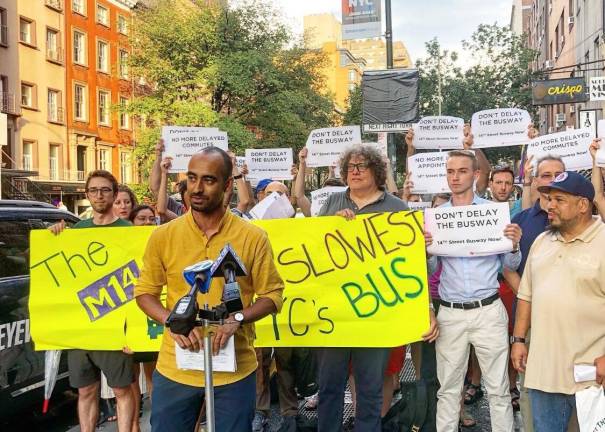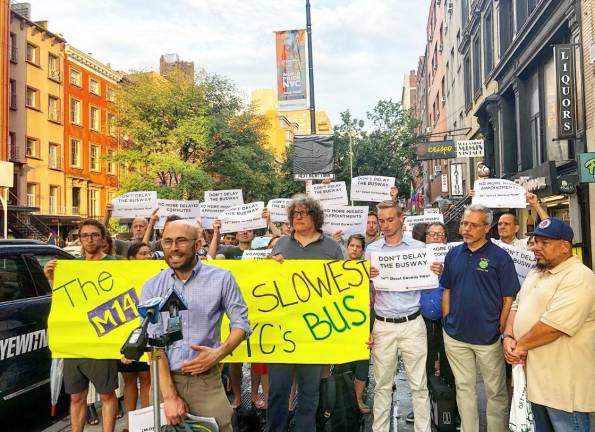The fight over the 14th Street busway has boiled down to an issue of class and privilege as transit advocates have painted the opponents of the program as wealthy elites who don’t ride the bus.
Before holding a rally in support of the long-awaited bus corridor, which would ban most private vehicles and prioritize bus riders, and against the lawsuit that has been holding it up for over a month, the group Transportation Alternatives released a study that found poor-performing transit disproportionately affects low income people and people of color.
As a contrast, at the rally on Aug. 21, speakers said that Arthur Schwartz, the lawyer representing the Chelsea and West Village neighborhood block associations in the suit against the city’s Department of Transportation, was an elite plaintiff who wants to protect his mansion on 12th Street.
“Bus riders earn a quarter of what people who live in Chelsea and the West Village earn. There’s a crisis of inequality on our streets,” said Danny Pearlstein, the policy and communications director of Riders Alliance, at Wednesday’s rally before about 25 supporters. “There’s also a crisis of inequality in the halls of our government and the halls of our legal system, which is why wealthy, powerful people from these neighborhoods have gone into court to waste bus riders’ time."
The study is an analysis of travel pattern data, demographic data and of facility data of areas accessible to the M14 route, and it found that the poorest bus service occurs in areas where median incomes are $10,000 less than the Manhattan median income. The M14 route itself has the second-highest ridership of any route on the island, carrying about 27,000 riders daily, but moves at an average pace of 4.3 miles per hour — the slowest of any route, according to advocates.
In a statement, the city’s comptroller, Scott Stringer, provided additional statistics on Manhattan bus ridership.
“Over 55 percent of Manhattan bus commuters are people of color, over 35 percent are foreign born, and over 60 percent are women,” Stringer said. “These riders are entitled to high-quality transit — period. The 14th Street Busway is an important step towards fairer and more equitable streets and a fairer and more equitable city.”
Who Takes the Bus
The characterization of his clients, and of himself, as wealthy elites, according to Schwartz, is not accurate. He said that he represents 18 block associations in the group, including the Fulton Houses Tenants Association, a NYCHA group.
“Most of the active members of the block associations are elderly (over 50) people who live in rent regulated apartments. Most of them take the bus frequently due to the lack of elevators (to access the subway),” Schwartz said. In kind, he was skeptical of whether or not the people who showed up to the rally would be affected by the bus corridor.
“I daresay that few of the people at their tiny ‘rally’ take the bus or live on the Lower East Side,” Schwartz said. “Throwing around phrases like ‘wealthy West-Villagers’ is hyperbole. Just isn't true.”
Much has been made of Schwartz’s own net worth, which advocates estimate to be $20 million dollars, and the brawl over the buses has gotten personal. Transit activists recently gathered outside of Schwartz’s home to protest his suit, to which Schwartz reacted by likening the protesters to “white hooded zealots” in a statement he gave to Gothamist.
Schwartz said his own finances have nothing to do with his work, and claimed that the leaders of Transportation Alternatives make more money than he does.
“The fact that I bought a house 38 years ago, and recently sold it for a lot of money, bears no relationship to what I do or who I care about,” Schwartz said. “ I am a lawyer for the poor and working people. I represent the bus drivers who drive those buses. I represent the elderly whose landlords, on both sides of 14th Street, are trying to evict them. I represent Black, Hispanic and other minority employees who are discriminated against at work.”
Appellate Panel Decision
Schwartz and his clients have been battling the city in court for months, stalling the plan that was scheduled to rollout on July 1 with a lawsuit. At the beginning of August, a judge dismissed the lawsuit and lifted the restraining order that had been holding up the plan’s implementation. But not long after, another judge granted Schwartz’s side an appeal, stalling the busway yet again.
Schwartz and the DOT will submit their arguments to an appellate panel, which will decide whether the stay on the bus corridor should remain in place.
Marco Conner, the co-deputy director of Transportation Alternatives, said at the rally that his group will keep fighting Schwartz on this issue for as long as it takes to get the program in motion.
“Arthur represents the past,” said Conner. “We are here to look forward; we’re looking forward to a city with world class transportation.”
“


